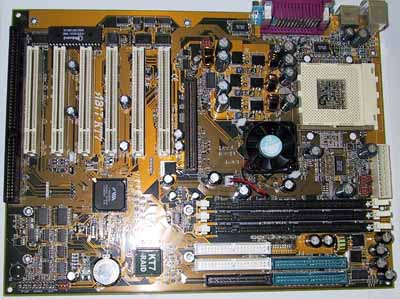
Original Link: https://www.anandtech.com/show/621
Buyer's Guide: Value Systems - September 2000
by Mike Andrawes on September 16, 2000 5:05 PM EST- Posted in
- Guides
Introduction
You do the research on the products. You read all the reviews. You even discuss with friends. But even with all that information, building a perfect, personalized system from scratch can be quite a daunting task. With that in mind, it’s no surprise that we’ve had request after request to provide some system recommendations.
Continuing our recent tradition since the third edition of the Buyer's Guide, the AnandTech Buyer's Guide is now split into two parts, one for value systems and the other for high-end ones. The Dream System will be included in the high-end part of the article. This is Part 1, featuring the value systems, while Part 2 with the high-end systems will be published in about two weeks.
In spite of the slight format change, the Guide will continue to provide some system recommendations in 3 categories – small office / home office (SOHO), gaming, and professional. Remember that these are just a few recommendations from us if we were building the systems. Obviously, each individual’s needs will vary greatly, but that’s the beauty of building a custom system - it can be tailored to fit those special needs.
Every component, from the motherboard to the case to the monitor, is covered for each system. Sample prices based on a review of popular vendors and price search engines across the web are included as well. Note that shipping is not included in these prices. An OS recommendation is included, but that price is not included in the total system price listed. Components that are not readily obtainable were automatically out of the running for any system in the Buyer’s Guide. Where possible, we’ll link to reviews of the individual products on AnandTech for more in depth information.
This Month
No major changes on the value front this month. Just the usual price drops that come with time. In some cases, we've decided to just drop the price of the system accordingly, while in others we've taken advantage of lower prices to upgrade the hardware. Windows Millennium Edition is finally available and makes its appearance in the Value Systems for the first time.
Value SOHO
The small office/home office machine has a unique set of requirements. It
must provide quick and snappy 2D performance and be very stable. The keys to
good performance on such a machine is lots of RAM and a fast hard drive. This
system should be able to run almost anything that most business users might
throw at it.
 Processor
– Intel Celeron 600 - $90
Processor
– Intel Celeron 600 - $90
The lone strong hold for Intel in our value system recommendations is here
in the Value SOHO machine. And the only reason Intel gets the nod here, where
CPU performance is not that critical in fact, is the ability to use the highly
integrated and inexpensive i810 chipset. Celeron makes the perfect choice for
our value SOHO machine– it’s cheap, but you still get a relatively fast processor
for the applications this machine will be used for. This month, prices have
dropped to the point where an FC-PGA Celeron is a reasonable option and the
600 MHz model makes the most sense since it's only a few bucks more than a 533
or 566. For overclockers, consider looking for a 533A or 566 since these CPU's
seem to hit 800 and 850 MHz, respectively, with minimal effort.
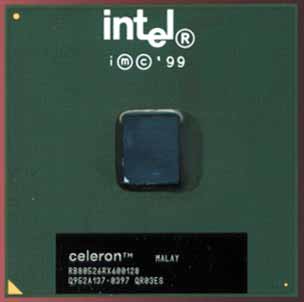
For more information on all Celeron processors, read our Celeron 700 Review.
Motherboard – AOpen MX3W
- $90
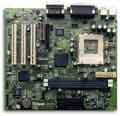 As
long as gaming performance isn’t involved, the i810 offers more than sufficient
power for a basic home or office system. Boards with the i810E currently cost
about $50 more than comparable i810 boards, and we don’t need the 133 MHz FSB
speed for our 66 MHz FSB Celeron anyway.
As
long as gaming performance isn’t involved, the i810 offers more than sufficient
power for a basic home or office system. Boards with the i810E currently cost
about $50 more than comparable i810 boards, and we don’t need the 133 MHz FSB
speed for our 66 MHz FSB Celeron anyway.
Since this will be a work machine, quite possibly the most important factor in a motherboard is stability, and the AOpen MX3W was one of the most stable i810 boards we’ve tested. It’s easy to find and costs under $90, making it a good choice for our system. It is, however, a microATX board, so if you need a lot of expansion, look for something in a full ATX form factor.
For a bit more, you can go with an i440BX based motherboard. However, you'll then have to pay for a video card as well. This route will give you better performance and better expandability, but at a greater price.
For more information, read our AOpen MX3W Review.
Memory – 128MB Nanya or Mushkin Budget PC133 SDRAM - $140
SDRAM prices are on the way up but at the same time you don't want to sacrifice quality since often times cheap generic SDRAM is the cause of a flaky system.
Mushkin Budget
PC133 w/ Nanya chips

Click to Enlarge
While we can't point you in the direction of our usual recommendation of 128MB Corsair PC133 SDRAM due to cost, Mushkin's Budget PC133 SDRAM which we included in our latest PC133 SDRAM Roundup actually makes use of NANYA SDRAM chips which happened to work fairly well as you can see from our roundup.
Video card – Integrated
i810 Video – “free”
Although the integrated video on the i810 is not incredibly fast, it is
more than sufficient to power basic Windows 2D applications.
For more information, see our i810 Chipset Review.
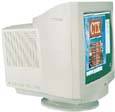 Monitor
– CTX VL950SL - $300
Monitor
– CTX VL950SL - $300
Monitors are one of the few computer components that you can usually hang
onto for years to come. With that in mind, we didn’t want to go with anything
smaller than a 19” on our value SOHO system – besides, once you’ve worked on
a monitor this big, there’s no going back.
The best deal we could find on a 19” monitor was the CTX VL950SL, which will run you about $300. It’s a shortneck model that uses the same 0.26 mm dot pitch tube that many of the bigger brands use. For a bit more, just about every monitor manufacturer is offering a value 19" model that would fit the bill.
 Case
– Fong Kai FK-603 - $60
Case
– Fong Kai FK-603 - $60
We loved the Fong Kai FK-603 when we first tested it, and it’s the perfect
case for our value systems. It’s only $60, but has plenty of space for everything
in our system. What makes it the clear choice is the ease of access to the
interior and excellent cooling for a case this size. Although not critical
for this system since it uses a Celeron, it also features an AMD approved power
supply.
You could also go with a microATX case to save a bit more money, but the price differential isn’t worth being locked into such limited expansion.
For more information, read our Fong Kai FK-603 Review.
Sound card – Integrated
AC97 Audio – “free”
The host-based AC97 CODEC will get you by for basic sound needs, but it
eats up precious CPU resources when in use. If you really need to keep the
cost as low as possible, stick with this, but otherwise get a “real” hardware
PCI sound card, even if you just want to play MP3’s.
For more information, see our i810 Chipset Review.
Speakers – Generic -
$20
The AC97 CODEC isn’t of the highest quality either, so there’s no need to
go with a hi-fi speaker set here. We just need something to get us by for basic
Windows sounds, so just go down to any local store and see what you can find
for $20.
Ethernet – Linksys EtherFast
10/100 - $20
We use Linksys products here in the AnandTech lab all the time and have
never been disappointed. Besides, at just $20 for a card with full support
directly from the manufacturer under the major OS’s, including Linux and Windows
2000, the EtherFast 10/100 is a deal that’s impossible to pass up.
Hard drive – IBM Deskstar
75GXP 15GB - $110
We still maintain that hard drive speed is one of the biggest bottlenecks
in a system, so we won’t skimp in this category. As such, we’ve simply chosen
a smaller version of the drive in our high-end system, the 15GB IBM Deskstar
75GXP, which also happens to be the fastest IDE drive available today and even
includes a Ultra ATA/100 interface. There is no performance difference between
this drive and the larger versions other than the available disk space.
If you simply need more space, you can either drop down to a 5400rpm drive or pay a bit more for a larger 7200rpm model. For more information read our IBM Deskstar 75GXP Review.
CD-ROM/CD-RW/DVD-ROM
- Name brand 40X – 50X CD-ROM - $40
While many will suggest going with the cheapest CD-ROM you can find, we
highly recommend going with a name brand, not just the cheapest generic. Our
experience with the no-names is that many of them do not perform as advertised,
and even have trouble reading less than perfect discs. Acer, Creative Labs,
Toshiba, and Teac all do an excellent job.
 OS
– Windows 2000 - $250
OS
– Windows 2000 - $250
You want to get work done, right? Well you definitely don’t want your system
crashing and destroying unsaved work all the time. Windows 2000 is the only
way to go for rock solid stability. If you don’t need all the features of Windows
2000, but want a more tried and true solution, drop back to Windows NT 4.0 but
note that you’ll lose access to USB peripherals, which many of the inexpensive
scanners out there use.
Bottom Line: $870 (without software)
Value Gaming
The concept behind this system is simple - the best balance of high frame rates
and a reasonable price.
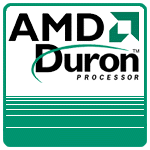 Processor
– AMD Duron 600 - $70
Processor
– AMD Duron 600 - $70
The Duron is perfect for our Value Gaming system since it performs within
5 - 10% of the regular Athlon. If you feel like overclocking, the Duron 600's
that we've tested have run at 900 - 950 MHz by simply boosting the voltage and
changing the clock multiplier. Of course, overclocking AMD's Socket-A CPU's,
including the Duron, has been the center of much controversy, but it's quite
easy with the right motherboard and the correct information. For full details
on overclocking the Duron, read our AMD Thunderbird
& Duron Overclocking Revealed Article and the "What
to look for in a KT133 Motherboard" section of our Socket-A
Motherboard Roundup for August 2000.
If you feel like spending about $50 more, you can get a Duron 700 but since you'll be limited by the memory bandwidth of your video card at the higher resolutions we decided that the extra 100MHz wouldn't help that much in games. As far as overclocking goes, the higher rated core seems to make no difference as our Duron 700's also topped out around 900 - 950 MHz.
For more information on all Duron processors, read our AMD Duron review.
Motherboard – ABIT KT7
- $150
We recently looked at as many Socket-A boards as we could get a hold of
and one board stood out head and shoulders above the rest - the ABIT KT7-RAID.
While that board is a bit expensive for a value system, ABIT still has a solution
for everyone, including the budget-conscious. By dropping the "RAID"
part of the product name, and the associated RAID features, the KT7 is available
for a much more reasonable $150. As we noted in the roundup, the KT7 is the
perfect board to overclock with thanks to its completely jumperless Soft Menu
III CPU setup.
The Asus A7V is also an excellent choice that also offers complete overclocking/multiplier control, albeit not in 100% jumperless form.
If you don't plan on overclocking, Gigabyte and Microstar offer solid products that can save you a a bit of money.
Memory – 128MB Nanya or Mushkin Budget PC133 SDRAM - $140
SDRAM prices are on the way up but at the same time you don't want to sacrifice quality since often times cheap generic SDRAM is the cause of a flaky system.
Mushkin Budget
PC133 w/ Nanya chips

Click to Enlarge
While we can't point you in the direction of our usual recommendation of 128MB Corsair PC133 SDRAM due to cost, Mushkin's Budget PC133 SDRAM which we included in our latest PC133 SDRAM Roundup actually makes use of NANYA SDRAM chips which happened to work fairly well as you can see from our roundup.
Video card – NVIDIA GeForce2
MX - $120
This month, we've moved to an NVIDIA GeForce2 MX based card for our value
gaming system. In virtually every situation, the MX performs like the older
GeForce 256 SDR, but costs $30-50 less than that older model. The MX does have
the advantage of a higher clocked core, and thus greater theoretical fillrate
and T&L speeds.
On the overclocking side, the 0.18-micron core of the GeForce2 MX allows for considerable core overclocking, even without a heatsink. However, memory bandwidth is where the bottleneck is, and thus overclocking the memory is the most efficient way to boost the performance of these cards. Read our GeForce2 MX Overclocking Guide for all the details.
GeForce2 MX cards are still just showing up on the market, so we can't recommend any particular model just yet. We've seen prices in the $120 range, with a few vendors dipping as low as $108 on some models. Note that a few GeForce2 MX's are available for even less, but with just 16MB of RAM. With the relatively small price differential, it's simply not worth cutting the memory in half at this point in time.
For more information, see our NVIDIA GeForce2 MX Review.
 Monitor
– CTX VL950SL - $300
Monitor
– CTX VL950SL - $300
Monitors are one of the few computer components that you can usually hang
onto for years to come. With that in mind, we didn’t want to go with anything
smaller than a 19” on our value gaming system – besides, once you’ve gamed on
a monitor this big, there’s no going back.
The best deal we could find on a 19” monitor was the CTX VL950SL, which will run you about $300. It’s a shortneck model that uses the same 0.26 mm dot pitch tube that many of the bigger brands use. For a bit more, just about every monitor manufacturer is offering a value 19" model that would fit the bill.
 Case
– Fong Kai FK-603 - $60
Case
– Fong Kai FK-603 - $60
We loved the Fong Kai FK-603 when we first tested it and it’s the perfect
case for our value systems. It’s only $60, but has plenty of space for everything
in our system. What makes it the clear choice is the ease of access to the
interior, excellent cooling for a case this size, and, most importantly, an
AMD approved power supply.
For more information, read our Fong Kai FK-603 Review.
Sound card – Sound Blaster
Live! Value OEM - $50
The SBLive! is only $50 for an OEM model and it's the best sound card out
there in our estimation, especially with Aureal in financial trouble and Diamond
dropping support for all graphics and audio products. If you really want to
save a few more bucks, go with any hardware-based PCI sound card that offers
good support. The Sound Blaster PCI 512 is a popular choice.
Speakers - Cambridge
Sound Works PCWorks Four Point Surround / Altec Lansing ACS54 - $70
We still want a good set of four channel speakers for our value gaming system,
and both the Cambridge PCWorks FPS and the Altec ACS54 fit our requirements
while maintaining a relatively low price of $70. If you don’t care about 4-channel
surround, there are a number of speaker systems that will provide higher quality,
but just stereo, sound at a similar price point.
Ethernet – Linksys EtherFast
10/100 - $20
We use Linksys products here in the AnandTech lab all the time and have
never been disappointed. Besides, at just $20 for a card with full support
directly from the manufacturer under the major OS’s, including Linux and Windows
2000, the EtherFast 10/100 is a deal that’s impossible to pass up.
Hard drive – IBM Deskstar
75GXP 15GB - $110
We still maintain that hard drive speed is one of the biggest bottlenecks
in a system, so we won’t skimp in this category. As such, we’ve simply chosen
a smaller version of the drive in our high-end system, the 15GB IBM Deskstar
75GXP, which also happens to be the fastest IDE drive available today and even
includes a Ultra ATA/100 interface. There is no performance difference between
this drive and the larger versions other than the available disk space.
If you simply need more space, you can either drop down to a 5400rpm drive or pay a bit more for a larger 7200rpm model. For more information read our IBM Deskstar 75GXP Review.
CD-ROM/CD-RW/DVD-ROM
– Name brand 40X – 50X CD-ROM - $40
While many will suggest going with the cheapest CD-ROM you can find, we
highly recommend going with a name brand, not just the cheapest generic. Our
experience with the no-names is that many of them do not perform as advertised,
and even have trouble reading less than perfect discs. Acer, Creative Labs,
Toshiba, and Teac all do an excellent job.
 OS
– Windows Millennium Edition - $170
OS
– Windows Millennium Edition - $170
Windows Millennium Edition (Windows ME) replaces Windows 98SE as the operating
system of choice for gamers. You get the benefits of Windows 98SE (top notching
gaming performance and compatibility) and gain a number of new features and
enhanced stability. Windows 98 users can upgrade for just $50.
Windows 2000 can be installed and booted to when its time to get some “real” work done. If you’re not nuts about the absolute highest frame rates at all times, you can go with Windows 2000 and gain quite a bit of stability and performance in office applications, while maintaining good gaming performance.
Bottom line: $1130 (without software)
Value Professional 3D
Professional 3D users tend to require higher-end components, so once again
we got for most bang for the buck, but with a little more flexibility as far
as price goes. CPU performance is critical and we need more RAM here than any
other system we've looked at previously. The graphics requirements are also
very different in the professional space and a large monitor is critical.
 Processor
– AMD Duron 700 - $120
Processor
– AMD Duron 700 - $120
As we proved in our Duron Review, the
700MHz part performs with the best of them when it comes to professional applications.
Whether you're building a cheap programming workstation or a sub $2000 OpenGL
powerhouse, the Duron is the perfect solution.
If you feel like overclocking, the Duron's that we've tested have run at 900 - 950 MHz by simply boosting the voltage and changing the clock multiplier. Of course, overclocking AMD's Socket-A CPU's, including the Duron, has been the center of much controversy, but it's quite easy with the right motherboard and the correct information. For full details on overclocking the Duron, read our AMD Thunderbird & Duron Overclocking Revealed Article and the "What to look for in a KT133 Motherboard" section of our Socket-A Motherboard Roundup for August 2000.
For more information on all Duron processors, read our AMD Duron review.
Motherboard – ABIT KT7
- $150
We recently looked at as many Socket-A boards as we could get a hold of
and one board stood out head and shoulders above the rest - the ABIT KT7-RAID.
While that board is a bit expensive for a value system, ABIT still has a solution
for everyone, including the budget-conscious. By dropping the "RAID"
part of the product name, and the associated RAID features, the KT7 is available
for a much more reasonable $150. As we noted in the roundup, the KT7 is the
perfect board to overclock with thanks to its completely jumperless Soft Menu
III CPU setup.
The Asus A7V is also an excellent choice that also offers complete overclocking/multiplier control, albeit not in 100% jumperless form.
If you don't plan on overclocking, Gigabyte and Microstar offer solid products that can save you a a bit of money.
Memory – 256MB Nanya or Mushkin Budget PC133 SDRAM (2x128MB DIMM’s) – $280
SDRAM prices are on the way up but at the same time you don't want to sacrifice quality since often times cheap generic SDRAM is the cause of a flaky system.
Mushkin Budget
PC133 w/ Nanya chips

Click to Enlarge
While we can't point you in the direction of our usual recommendation of 128MB Corsair PC133 SDRAM due to cost, Mushkin's Budget PC133 SDRAM which we included in our latest PC133 SDRAM Roundup actually makes use of NANYA SDRAM chips which happened to work fairly well as you can see from our roundup.
Since we couldn't find any 256MB modules with the affordable NANYA chips we decided to simply recommend using two 128MB modules. If you think you'll need significantly more memory in the future, consider paying the extra money necessary to get a single 256MB stick.
Video card – NVIDIA GeForce2
MX - $120
This month, we've moved to an NVIDIA GeForce2 MX based card for our value
professional system. As far as T&L power goes, the GeForce2 MX provides
30% more T&L power than the original NVIDIA Quadro and is nearly as fast
as the GeForce2 GTS or Quadro2 Pro/MXR in applications that are not fillrate
limited.
On the overclocking side, the 0.18-micron core of the GeForce2 MX allows for considerable core overclocking, even without a heatsink. However, memory bandwidth is where the bottleneck is, and thus overclocking the memory is the most efficient way to boost the performance of these cards. Read our GeForce2 MX Overclocking Guide for all the details.
GeForce2 MX cards are still just showing up on the market, so we can't recommend any particular model just yet. We've seen prices in the $120 range, with a few vendors dipping as low as $108 on some models. Note that a few GeForce2 MX's are available for even less, but with just 16MB of RAM. With the relatively small price differential, it's simply not worth cutting the memory in half at this point in time.
For more information, see our NVIDIA GeForce2 MX Review.
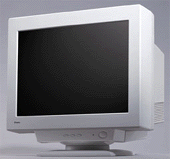 Monitor
– iiYama VisionMaster PRO 450 - $650
Monitor
– iiYama VisionMaster PRO 450 - $650
Using a Mitsubishi Diamondtron NF, the iiYama VisionMaster Pro 450 provides
a perfectly flat display surface using the same technology in Sony’s FD Trinitron
models, but at a lower cost. Make sure you can deal with the damper wires that
all Trinitron style tubes have. The VisionMaster PRO 450 is a 19” monitor and
it is highly recommended by us at AnandTech and owners alike. If you’ve got
the funds, we highly recommend you go with the 22” VisionMaster PRO 510 for
about $1000.
For more information, read our iiYama VisionMaster PRO 450 and VisionMaster PRO 510 Reviews.
Case
Supermicro SC750-A Full Tower ATX - $150
Fong Kai FK-320ATX Mid Tower ATX - $120
We need a case that can handle anything we can throw at it, but at a reasonable
price level. That case is the Supermicro SC750-A full tower and is available
for about $150 with an Athlon approved 300W Sparkle power supply. A total of
ten drive bays and the ability to accept an extended ATX motherboard ensures
that this system will always have room for upgrades.
If you want something a little smaller than the monstrous SC750-A for your home or office, consider the Fong Kai FK-320ATX. It offers plenty of room to work inside, is well built, provides excellent cooling, and even includes an Athlon 1 GHz approved Enhance 730-ATX power supply.
For more information, read our Supermicro SC750-A and Fong Kai FK-320ATX Reviews.
 Sound
card – Sound Blaster Live! Value OEM - $50
Sound
card – Sound Blaster Live! Value OEM - $50
The choice here is simple – SBLive!, since Creative is the only manufacturer
offering complete driver support under Windows 2000. If you want to save a
bit more money, go with any name brand card supported under Windows 2000.
Speakers – Generic -
$20
We just need something to get us by for basic Windows sounds, so just go
down to any local store and see what you can find for $20.
Ethernet – Linksys EtherFast
10/100 - $20
We use Linksys products here in the AnandTech lab all the time and have
never been disappointed. Besides, at just $20 for a card with full support
directly from the manufacturer under the major OS’s, including Linux and Windows
2000, the EtherFast 10/100 is a deal that’s impossible to pass up.
Hard drive – IBM Deskstar
75GXP 15GB - $110
We still maintain that hard drive speed is one of the biggest bottlenecks
in a system, so we won’t skimp in this category. As such, we’ve simply chosen
a smaller version of the drive in our high-end system, the 15GB IBM Deskstar
75GXP, which also happens to be the fastest IDE drive available today and even
includes a Ultra ATA/100 interface. There is no performance difference between
this drive and the larger versions other than the available disk space.
If you simply need more space, you can either drop down to a 5400rpm drive or pay a bit more for a larger 7200rpm model. For more information read our IBM Deskstar 75GXP Review.
CD-ROM/CD-RW/DVD-ROM
- Name brand 40X – 50X CD-ROM - $40
While many will suggest going with the cheapest CD-ROM you can find, we
highly recommend that you pick a name brand, not just the cheapest generic.
Our experience with the no-names is that many of them do not perform as advertised
and even have trouble reading less than perfect discs. Acer, Creative Labs,
Toshiba, and Teac all do an excellent job.
 OS
– Windows 2000 Professional - $250
OS
– Windows 2000 Professional - $250
The choice here is clear – Windows 2000 Professional is the latest and greatest
OS from Microsoft that provides all the functionality of NT 4.0, but enhanced
hardware support. If you want to stick with a more tried and true solution,
go with NT 4.0 Workstation.
Bottom line: $1710 (without software)
Summary
|
|
Value
SOHO
|
| CPU |
Intel
Celeron 600 - $90
|
| Motherboard |
AOpen
MX3W - $90
|
| Memory |
128MB
Nanya/Mushkin Budget PC133 SDRAM - $140
|
| Video Card |
Integrated
i810 - $0
|
| Monitor |
CTX
VL950SL - $300
|
| Case |
Fong
Kai FK-603 - $60
|
| Sound Card |
Integrated
AC97 Audio - $0
|
| Speakers |
Generic
- $20
|
| Ethernet |
Linksys
EtherFast 10/100 - $20
|
| Hard Drive |
IBM
Deskstar 75GXP 15GB - $110
|
| Hard Drive Controller |
Integrated
on motherboard - $0
|
| CD-ROM |
Name
brand 40X – 50X CD-ROM - $40
|
| CD-RW |
None
|
| Bottom line |
$870
|
|
|
Value
Gaming
|
| CPU |
AMD
Duron 600 - $70
|
| Motherboard |
ABIT
KT7 - $150
|
| Memory |
128MB
Nanya/Mushkin Budget PC133 SDRAM - $140
|
| Video Card |
NVIDIA
GeForce2 MX - $120
|
| Monitor |
CTX
VL950SL - $300
|
| Case |
Fong
Kai FK-603 - $60
|
| Sound Card |
Sound
Blaster Live! Value OEM - $50
|
| Speakers |
Cambridge
PCWorks Four Point Surround - $70
Altec Lansing ACS54 - $70 |
| Ethernet |
Linksys
EtherFast 10/100 - $20
|
| Hard Drive |
IBM
Deskstar 75GXP 15GB - $110
|
| Hard Drive Controller |
Integrated
on motherboard - $0
|
| CD-ROM |
Name
brand 40X – 50X CD-ROM - $40
|
| CD-RW |
None
|
| Bottom line |
$1130
|
|
|
Value
Professional
|
| CPU |
AMD
Duron 700 - $120
|
| Motherboard |
ABIT
KT7 - $150
|
| Memory |
2
x 128MB Nanya/Mushkin Budget PC133 SDRAM - $280
|
| Video Card |
NVIDIA
GeForce2 MX - $120
|
| Monitor |
iiYama
VisionMaster PRO 450 - $650
|
| Case |
Supermicro
SC750-A Full Tower ATX - $150
Fong Kai FK-320ATX Mid Tower ATX - $120 |
| Sound Card |
Sound
Blaster Live! Value OEM - $50
|
| Speakers |
Generic
- $20
|
| Ethernet |
Linksys
EtherFast 10/100 - $20
|
| Hard Drive |
IBM
Deskstar 75GXP 15GB - $110
|
| Hard Drive Controller |
Integrated
on motherboard - $0
|
| CD-ROM |
Name
brand 40X – 50X CD-ROM - $40
|
| CD-RW |
None
|
| Bottom line |
$1710
|
Final Words
And that concludes our recommendations for value systems in the third edition of the AnandTech Buyer's Guide. In about 2 weeks, we'll be covering high-end systems, including the famous AnandTech Dream System.
As always, we’re open to any suggestions you may have. Remember that these are merely recommendations for a few system configurations. We know a lot of you won’t agree with the exact components chosen here, and we expect that, so plan on tweaking things a bit to get the perfect system for your needs. When sending in suggestions, remember that all the components must be readily available in the market today in order to be considered for the Buyer’s Guide.

